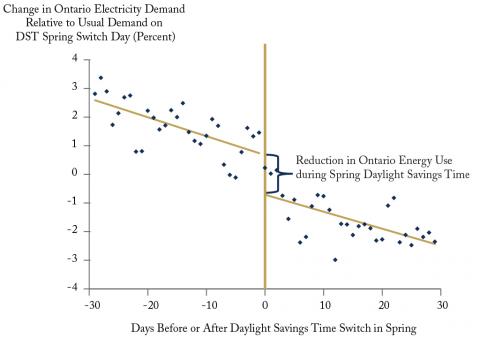From: Nic Rivers and Blake Shaffer
To: Canadians with one less hour of sleep
Date: March 7, 2017
Re: Does Daylight Saving Time Reduce Energy Consumption? (Part 1)
Every spring and fall, clocks across much of North America, Europe and a few other parts of the world are shifted forward or back one hour. This practice is closely followed by another semi-annual ritual: debate over the costs and benefits of Daylight Saving Time (DST). This year, in Alberta, the debate has even made its way to the floor of the legislature, with a proposal to abolish DST.
On the one hand, proponents of DST see value in shifting light later in the day to capture the benefits of having extra light after working hours. The extra ambient light leads to improved health outcomes (10% more caloric burn from increased recreation activity) and safety (7% less robberies) immediately following the transition to DST.
Opponents, on the other hand, argue that DST imposes a variety of costs. Changing sleep patterns leads to a 6% increase in fatal vehicle accidents and can increase the incidence of heart attacks. Farmers argue that DST disrupts coordination between their operations, which follow natural sun times, and their markets and distributors, who follow clock time. And of course, the general complaint voiced by most parents (including the authors) is of having to wake kids up that one hour earlier every March.
But the primary rationale for DST has long been energy savings. This is evidenced by the fact DST came into being during WWI as an energy-saving measure, and was made permanent in the US and Canada after the energy crisis of the 1970s.
Whether DST does reduce energy use, however, remains a question of dispute.
A recent Australian study examines this question by exploiting a temporary delay in DST transition in a subset of Australian states due to the Olympics. The study finds that DST causes a shift in electricity demand, from evening to morning, but leaves the overall level of electricity demand unchanged.
Another recent report examines differences in electricity demand across counties in the state of Indiana, some of which impose DST and others which don’t, and finds that DST increases electricity use by roughly 1%.
Lastly, one of us has examined the effect of DST on electricity demand in the province of Ontario. After controlling for various factors that affect electricity use, the study concludes that DST decreases electricity use in Ontario by 1.5% (see figure), with the effect concentrated at the time of the spring transition.
With different studies producing different results, what are we to conclude? There appears to be no universal answer as to how DST affects energy use. In part two of this memo, one of us proposes and tests a mechanism to explain and reconcile the different regional effects.
Nic Rivers is Associate Professor in the Graduate School of Public and International Affairs and Institute of the Environment at the University of Ottawa
Blake Shaffer is a PhD Candidate in the Department of Economics at the University of Calgary and Fellow-in-Residence at the C.D. Howe Institute
To send a comment or leave feedback, email us at blog@cdhowe.org.






